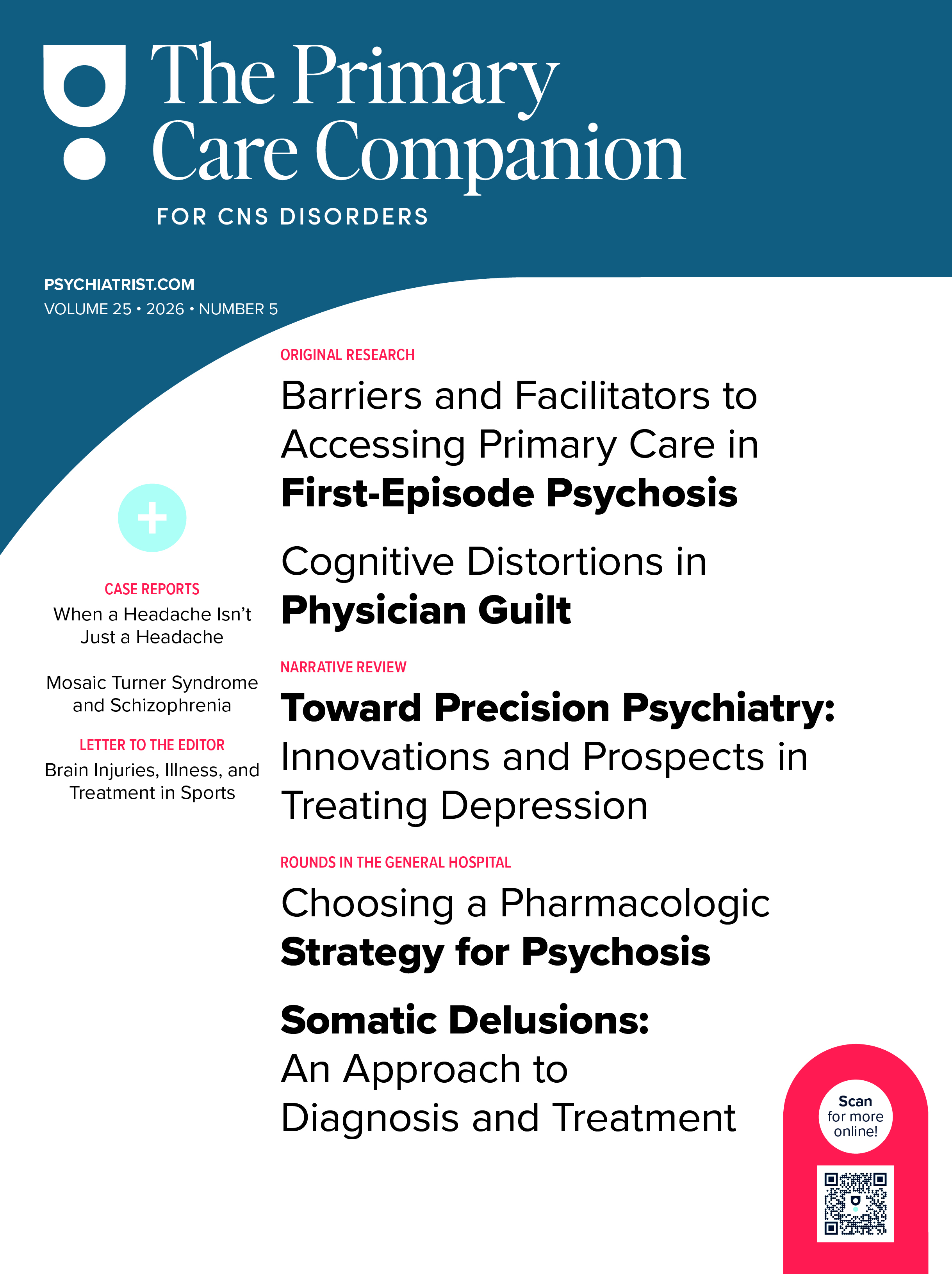Abstract
Importance: Quality improvement in community mental health care is crucial for enhancing patient outcomes and service effectiveness. However, the field faces challenges due to the heterogeneity of initiatives and limited comprehensive studies.
Observations: A search was conducted in PubMed using various combinations of the following terms: quality improvement, quality enhancement, community mental health, and community mental health services. The review included 23 studies published in English, with no publication date restrictions. The analysis identified 6 recurring themes as key components of successful quality improvement initiatives: sustainability in service delivery, community engagement for quality assurance, telehealth interventions, integration of physical and metabolic health, educational/training interventions, and policy and governance interventions.
Conclusions and Relevance: Sustainable service delivery relies on cost-effective interventions, collaborative care across governmental and nongovernmental organizations, and the integration of training and digital health solutions to promote and ensure mental well-being. Telehealth serves as a platform for mental health services, enhancing accessibility, minimizing geographical barriers, and improving service efficiency. Community engagement helps promote mental well-being and reduces mental health disparities. Educational initiatives equip professionals with the skills to address social determinants of health, strengthening their ability to deliver effective care to specific populations. Robust policies and governance are essential for strengthening the community mental health system, ensuring equity, and promoting sustainable service delivery. The findings provide valuable insights for policymakers, practitioners, and researchers seeking to improve care in community settings.
Prim Care Companion CNS Disord 2025;27(5):25nr03962
Author affiliations are listed at the end of this article.
Quality improvement (QI) in community mental health care is a systematic, interdisciplinary approach to optimize outcomes and foster professional development through continuous learning and adaptation. The quality of care is one of the major determinants of the effectiveness, safety, and patient-centeredness of mental health services, which has a direct influence on health outcomes. Good quality services play a pivotal role in strengthening and widening of community mental health services by ensuring accessible, acceptable, affordable, and comprehensive mental health care within community settings.1,2 The quality of community mental health care relies on multiple interconnected factors, requiring a multifaceted evaluation approach that considers service delivery, patient outcomes, and systemic influences.
Various governmental and nongovernmental organizations have launched initiatives to improve the quality of community mental health care. Primarily focused on treatment quality, these initiatives employ systematic approaches to enhance service delivery, patient satisfaction, and clinical outcomes. They often involve continuous refinement of processes and implementation of guidelines aligned with international standards, aiming to ensure comprehensive and effective care, especially in underserved areas, and promote mental health across communities.3–5 Beyond treatment-focused initiatives, structural and organizational elements like funding, policy support, and integration with primary care are also vital for sustaining and enhancing the effectiveness of improvement efforts.6 Furthermore, digital health technologies, such as telepsychiatry and mobile mental health apps, are offering innovative solutions to bridge gaps in access and service delivery, particularly in resource-limited settings. These advancements enable timely interventions, improve patient engagement, and support the continuity of care, ultimately improving quality of mental health care systems.7,8 While numerous initiatives aim to improve the quality of community mental health care, there remains a limited understanding of their impact, effectiveness, scalability, and potential for integration into local services, largely due to the absence of comprehensive, integrated analyses of these efforts.
Given the scarcity of literature comprehensively addressing QI initiatives in community mental health care, this narrative review aims to explore the existing evidence, identify key themes, and highlight best practices that contribute to QI in community mental health care.
METHODS
This study employed a narrative review methodology to map the existing literature on QI in community mental health care. Due to the heterogeneous nature of QI initiatives and the limited availability of meticulously explored studies in this area, a narrative approach was thought to be appropriate for synthesizing diverse findings and identifying key themes. A search was conducted primarily in the PubMed database using various combinations of the following terms: quality improvement,quality enhancement, community mental health, and community mental health services. We included only original investigations evaluating QI projects in community mental health care, limiting inclusion to articles published in English. No publication date restriction was applied. A descriptive analysis was used to summarize the key findings and identify recurring themes within the literature. The descriptive analysis involved the following steps:
- Data Extraction: We devised a meticulously structured data extraction form to systematically gather information from each included study. This instrument captured essential elements, such as the nation in which the study was conducted, the study design, the interventions employed, and the outcomes observed.
- Thematic Analysis: The extracted data were subsequently subjected to a rigorous thematic analysis. This process entailed the identification of recurrent patterns and motifs pertinent to quality enhancement strategies within community mental health care.
- Synthesis and Interpretation: We meticulously synthesized the findings from individual studies to construct a cohesive narrative regarding the current state of knowledge in this domain. This endeavor entailed a thorough comparison and contrast of the results from various studies, discerning areas of consensus and contention, and ultimately drawing overarching conclusions about the efficacy and feasibility of diverse QI methodologies.
RESULTS
This review included 23 studies conducted between 2015 and 2024. The majority of studies were conducted in the United States, with 2 originating from Australia and 1 each from the Netherlands, United Kingdom, South Africa, and Peru. Most studies were done in a single community setting. The most common study design was prospective, followed by randomized controlled trials, retrospective designs, and cluster randomized trials. Other study designs included case studies, descriptive studies, qualitative studies, and cross-sectional studies. The studies focused on various aspects of QI initiatives within community mental health services.
Through analysis, several recurring themes emerged as critical components of successful initiatives. These included (1) sustainability in community mental health service delivery, (2) community engagement for quality assurance, (3) telehealth interventions, (4) integration of physical and metabolic health, (5) educational/training interventions, and (6) policy and governance interventions. The results pertaining to each of these key aspects are detailed below.
Sustainability in Community Mental Health Service Delivery
Ensuring the long-term sustainability of community mental health services is crucial for maintaining quality of care and expanding access, particularly for underserved populations. Strengthening resources and implementing cost-effective strategies are key to achieving this sustainability. A recent case study used patient flow analysis (PFA) in a community mental health clinic to streamline outpatient intakes. PFA pinpointed bottlenecks, guided a targeted intervention, and proved to be a low-cost method for optimizing and sustaining efficient intake workflows in clinics.9 Aligning service delivery models with the specific needs of the target population also enhances effectiveness and supports long-term sustainability.10,11 Furthermore, health care policy initiatives and collaborations among government agencies, nongovernmental organizations, and local communities facilitate sustainable mental health care and social services. These collaborations support the long-term delivery of services. Culturally appropriate interventions are equally important for improving service quality.12–16
Training and educational integration in health care are critical to the sustainability of community mental health services. High-quality training programs ensure that mental health practitioners have the necessary skills and knowledge to meet the diverse needs of the populations they serve. Furthermore, digital health, particularly telepsychiatry, is increasingly shaping the sustainability of community mental health care by enhancing accessibility, cost-effectiveness, and efficiency. This approach directly improves the quality, consistency, and availability of care. Lastly, robust policies are essential for ensuring the sustainability of mental health services, providing a framework for consistent service delivery.13,16–23
Telehealth Interventions
Digital technologies offer a powerful and universal platform for delivering mental health services, improving access, reducing geographical barriers, and enhancing service efficiency. A case study by Celedonia et al9 suggested that PFA is a low-cost and low-technology QI method that led to improved service delivery, and in 2020, Arya10 conducted a cross-sectional study in Australia and emphasized that telepsychiatry in particular ensures continuity of care for individuals experiencing mental distress by enabling remote connections with mental health professionals.9,10 These digital interventions, including telehealth, offer valuable opportunities to improve the quality, accessibility, and reach of community mental health services, particularly for underserved populations.24
Educational/Training Interventions
Education and training among health care professionals, caregivers, and the broader community are indispensable for augmenting the quality of community mental health services. Scorza et al25 conducted an intervention study in Peru, while Sibeko et al26 executed a cohort study in South Africa. Both investigations illuminated the significant impact of incorporating mental health training within the community mental health framework.25,26 These initiatives empowered professionals with the acumen to comprehend and address the structural and social determinants of health, thereby enabling them to harness available resources to provide comprehensive, patient-centered care. Researchers observed that multidisciplinary team training and quality enhancement initiatives bolster staff expertise and safety, ensuring the delivery of evidence-based, high-caliber services.11,22,23,27,28
Educational interventions are crucial for delivering essential mental health knowledge and skills to health care professionals, caregivers, and the wider community, representing an important QI strategy in community mental health. Multiple studies demonstrate the acceptability, feasibility, and effectiveness of community mental health training programs, which enhance knowledge, confidence, and attitudes among health care professionals.10,23,25–27 The “train-the-trainer” approach, involving psychiatrists, nurse care managers, cognitive-behavioral therapy trainers, QI specialists, and community engagement experts, strengthens the workforce and promotes sustainable improvements in service delivery and quality of care.13,22,29 Furthermore, research highlights that investing in training health care professionals strengthens staff capacity in sectors beyond mental health, including homelessness and social services, particularly benefiting racial-ethnic minority communities where there is historical distrust of health care systems and research.14
Psychoeducation for caregivers and patients plays a pivotal role in fostering effective support and self-care. Researchers highlight a significant concern that, while the integration of technology in training has expanded access to mental health education and strengthened health care facilities, particularly in underserved communities, challenges such as digital literacy and accessibility must still be addressed.13,14,18
Policy and Governance Interventions in Community Mental Health
Two studies conducted in the United States by Hamm and Conley30 and Chung et al12 underscore that effective policies and governance are paramount for the provision of community-based mental health services, ensuring equity and fostering sustainable mental health initiatives. Policy integration plays a pivotal role in strengthening community mental health care services, and many QI initiatives target this crucial area. Studies highlight that improving care for populations with serious mental illness, especially vulnerable groups, necessitates the integration of health policies. Furthermore, policy-driven approaches, such as accountable health communities, accountable care organizations, and Medicaid behavioral health homes, offer incentives to foster relationships between health care and social services, helping to address the complex needs of under-resourced communities.12,13,17,22 A policy-driven approach in community mental health care facilities enhances service integration and ensures high-quality medical care. For example, smoking cessation programs, supported by smoke-free policies in mental health settings, have been shown to improve both mental and physical health outcomes. Therefore, understanding community needs is paramount for designing effective, integrated policies that promote equitable and accessible mental health care.14,21,30
Community Engagement for Quality Assurance
A qualitative analysis conducted among 24 participants in the Netherlands explored collaboration between health care services and the community.16 The study found that improved communication among health care providers contributed to the mental health of community residents, highlighting the importance of relational coordination and communication in community mental health care.16 A prospective cohort study conducted across 7 independent practitioner-based primary care clinics in New York City utilized a prospective design to investigate the ramifications of appointment scheduling and reminder systems implemented by clinic staff for primary care physicians.27 The findings indicated a notable increase in referrals to psychiatric services and enhanced follow-up rates, suggesting that straightforward interventions such as optimized appointment systems can markedly enhance access to mental health services within primary care environments. Community engagement plays a significant role in ensuring the quality of community mental health services, representing an important area for QI. Research shows that community mental health care initiatives improve mental health outcomes, particularly in underserved populations. By fostering community involvement, these initiatives enhance accessibility, reduce stigma, and ensure that services are culturally appropriate.16,22,31,32 Furthermore, collaborative mental health care models have been found to be more effective and cost-effective than usual care across diverse practice settings, helping to reduce mental health disparities.27 For individuals at high risk of hospitalization or homelessness, assertive community treatment teams provide intensive, recovery-oriented, multidisciplinary, evidence-based care, offering comprehensive community-based support.17
Integration of Physical and Metabolic Health
Hamm and Conley30 conducted a prospective cohort study in the United States aimed at enhancing access to laboratory monitoring for individuals afflicted with serious mental illness. Plever et al15 undertook a retrospective study in Australia to explore a collaborative approach to augment the assessment of physical health in adult consumers diagnosed with schizophrenia within Queensland’s mental health services. Conley et al28 executed a prospective QI project focused on the integration of personalized medicine into psychiatric assertive community treatment in the United States. Integration of physical and metabolic health for patients attending community mental health services represents a critical area for QI, as highlighted by the above studies. Researchers have noted that psychotropic medications, while essential for managing serious mental illness, can increase metabolic, endocrine, and cardiac risks, potentially leading to polypharmacy and higher premature mortality.21 Therefore, routine laboratory monitoring of psychotropic medication levels, smoking status, and physical health parameters is essential to ensure safe and effective treatment for individuals with severe mental illness.28,30 The Collaborative Chronic Care Model is an evidence-based practice that has demonstrated effectiveness in improving both physical and mental health outcomes for individuals with mood disorders. Furthermore, collaborative models within mental health services effectively integrate physical health assessments for individuals with severe mental illness.15,24 Community engagement and planning have also been found to be more effective than other approaches in increasing physical activity and improving physical health-related quality of life.13,14
DISCUSSION
This narrative review underscores the multifaceted approaches employed by clinicians and researchers to improve the quality of community mental health services. Sustainability is paramount for continuous and effective care delivery, with stakeholder engagement, resource management, and robust infrastructure acting as critical pillars. However, various factors can present significant barriers to stakeholder engagement, including fragile health systems, competing priorities, limited funding, and crises such as political instability, conflict, and natural disasters.33,34 Recognizing the importance of stakeholder involvement, initiatives that strengthen stakeholder engagement in mental health facilities are essential for overall health system improvement.
Telehealth interventions represent another effective model for improving the quality of community mental health services, particularly by enhancing accessibility for low-income, uninsured, and publicly insured individuals. One study demonstrated the feasibility and acceptance of using the Internet, electronic adherence monitors, and telelactation services in rural, underserved populations, leading to improved access to care.35 However, it is important to acknowledge that populations in under-resourced communities may face challenges accessing telehealth services due to poor e-health literacy, which can act as a significant barrier to expanding telehealth services.36
Training and educational interventions aimed at enhancing the health literacy, confidence, and attitudes of professionals, caregivers, and the broader community represent another crucial QI strategy in community mental health settings. Beyond improving knowledge, attitudes, and practices related to mental health care, studies highlight that training-specific professionals, such as community pharmacists, can improve medication adherence among patients and contribute to reducing polypharmacy for individuals with mental illness.37
A policy-driven approach in community mental health care facilities enhances service integration and ensures high-quality medical care; therefore, understanding the needs of the community is crucial for designing effective policies. The integration of health policies and practices promotes an equitable health system and protects health facilities.38 As defined in one study, health policy encompasses those actions of governments and other stakeholders in society that are aimed at improving population health.39 Therefore, initiatives should strive to understand the needs of the community in designing the effective policies.
Community engagement is another critical aspect of QI in community mental health services. Studies show that collaborative mental health care models are more effective and cost-effective than usual care across diverse practice settings, helping to reduce mental health disparities. However, successful implementation of these collaborative care models requires addressing key barriers, such as poor mental health literacy and insufficient specialist consultation and care coordination for primary care practitioners.40 To address these barriers, implementing a collaborative care approach involving case management, patient and provider education, systematic follow-up, psychological interventions, and shared decision-making with patients can yield better outcomes.41
Integration of physical and metabolic health is crucial for the well-being of patients with mental disorders and an essential QI initiative. Psychotropic medications, while necessary, can increase the risk of metabolic disorders; therefore, routine laboratory monitoring of medication levels and physical health parameters is essential for safe and effective treatment.42 However, a significant challenge lies in ensuring consistent and accessible monitoring, particularly in under-resourced community mental health settings where access to specialized medical care may be limited.
Our scoping review elucidates both the potential and the precarious nature of contemporary QI research within community mental health care services. Among the 23 studies scrutinized, 6 overarching thematic objectives emerged; however, the corpus of evidence is strikingly fragmented: nearly all initiatives were singularly focused within high-income Western contexts, employed a variety of disparate study designs, and infrequently provided long-term longitudinal follow-up data. Consequently, no single theme attained the design consistency, replicability, or effect size robustness requisite for advocating immediate large-scale dissemination.
The gaps are most conspicuous where need is greatest. Nearly, every study originated from countries with mature community–mental health infrastructures, while low- and middle-income nations, particularly those in the global south, remained almost entirely unrepresented. This geographic skew limits generalizability and leaves unanswered how QI interventions might perform in resource-constrained or culturally diverse contexts. Equally noteworthy is the paucity of work on integrated care models that address the well-documented excess burden of physical illness among people with severe mental disorders. In light of these deficiencies, we propose 3 priorities for future research: (1) well-powered, multicenter comparative trials that include sites from diverse economic regions, especially the global south; (2) culturally tailored, cost-effective, scalable interventions that can be embedded in nascent community mental health care systems; and (3) explicit evaluation of scalability and sustainability indicators, such as workforce training requirements and long-term cost offsets. Advancing these priorities is essential to transform a set of isolated QI projects into a coherent, internationally relevant evidence base capable of guiding policy and practice.
CONCLUSIONS
This narrative review highlights the multifaceted approach to QI in community mental health services, with a focus on sustainability, community engagement, telehealth interventions, integration of physical and metabolic health, educational and training programs, and policy and governance measures. Sustainable service delivery relies on cost-effective interventions, collaborative care across governmental and nongovernmental organizations, and the integration of training and digital health solutions to promote and ensure mental well-being. Telehealth serves as a platform for mental health services, enhancing accessibility, minimizing geographical barriers, and improving service efficiency. Community engagement helps promote mental well-being and reduces mental health disparities. Educational initiatives equip professionals with the skills to address social determinants of health, strengthening their ability to deliver effective care. These methods help provide care to specific populations. Lastly, robust policies and governance are essential for strengthening the community mental health system, ensuring equity, and promoting sustainable service delivery.
Article Information
Published Online: October 9, 2025. https://doi.org/10.4088/PCC.25nr03962
© 2025 Physicians Postgraduate Press, Inc.
Submitted: March 9, 2025; accepted June 20, 2025.
To Cite: Mangalamchery V, Vaseel M, Uvais NA. Quality improvement in community mental health care. Prim Care Companion CNS Disord 2025;27(5):25nr03962.
Author Affiliations: IQRAA International Hospital and Research Centre, Calicut, Kerala, India (all authors).
Corresponding Author: N. A. Uvais, MBBS, DPM, FRSPH, FRSB, Department of Psychiatry, Iqraa International Hospital and Research Centre, Calicut, Kerala, India ([email protected]).
Relevant Financial Relationships: None.
Funding/Support: None.
Clinical Points
- Sustainable service delivery relies on cost-effective interventions, collaborative care across governmental and nongovernmental organizations, and the integration of training and digital health solutions to promote and ensure mental well-being.
- Telehealth serves as a platform for mental health services, enhancing accessibility, minimizing geographical barriers, and improving service efficiency.
- Community engagement helps promote mental well-being and reduces mental health disparities.
References (42)

- World Health Organization. Quality of care [Internet]. World Health Organization; 2025. Accessed September 2, 2025. https://www.who.int/health-topics/quality-of-care#tab=tab_1.
- Hu D, Stewart V, Wheeler AJ, et al. Characteristics of quality improvement interventions to improve physical healthcare in mental health settings: a scoping review protocol. BMJ Open. 2024;14(7):e083753. PubMed CrossRef
- Behere PB, Nagdive AB, Behere AP, et al. Innovation in community psychiatry for the delivery of mental health services: the Sawangi model. J Neurosci Rural Pract. 2020;11(4):593–596. PubMed CrossRef
- Bauer AM, Azzone V, Goldman HH, et al. Implementation of collaborative depression management at community-based primary care clinics: an evaluation. Psychiatr Serv. 2011;62(9):1047–1053. PubMed CrossRef
- Bauer AM, Azzone V, Alexander L, et al. Are patient characteristics associated with quality of depression care and outcomes in collaborative care programs for depression? Gen Hosp Psychiatry. 2012;34(1):1–8. PubMed CrossRef
- Forman-Hoffman VL, Middleton JC, McKeeman JL, et al. Quality improvement, implementation, and dissemination strategies to improve mental health care for children and adolescents: a systematic review. Implement Sci. 2017;12(1):93. PubMed CrossRef
- Currey D, Hays R, Torous J. Digital Phenotyping models of symptom improvement in college mental health: generalizability across two cohorts. J Technol Behav Sci. 2023;8(4):368–381. CrossRef
- Philippe TJ, Sikder N, Jackson A, et al. Digital health interventions for delivery of mental health care: systematic and comprehensive meta-review. JMIR Ment Health. 2022;9(5):e35159. PubMed CrossRef
- Celedonia KL, Klingensmith SA, Strickler A. Using patient flow analysis to streamline intakes at a community mental health clinic. Community Ment Health J. 2021;57(4):796–800. PubMed CrossRef
- Arya DK. Case management, care-coordination and casework in community mental health services. Asian J Psychiatr. 2020;50:101979. PubMed CrossRef
- Adams A, Perry J, Young S. Improving the process of zoning in a community mental health team. BMJ Open Qual. 2020;9(1):e000659. PubMed CrossRef
- Chung B, Ong M, Ettner SL, et al. 12-Month cost outcomes of community engagement versus technical Assistance for depression quality improvement: a partnered, cluster randomized, comparative-effectiveness trial. Ethn Dis. 2018;28(Suppl 2):349–356. PubMed CrossRef
- Ong MK, Jones L, Aoki W, et al. A community-partnered, participatory, cluster-randomized study of depression care quality improvement: three-year outcomes. Psychiatr Serv. 2017;68(12):1262–1270. PubMed CrossRef
- Barceló NE, Lopez A, Tang L, et al. Community engagement and planning versus resources for services for implementing depression quality improvement: exploratory analysis for Black and Latino adults. Ethn Dis. 2019;29(2):277–286. PubMed CrossRef
- Plever S, McCarthy I, Anzolin M, et al. A collaborative approach to improve the assessment of physical health in adult consumers with schizophrenia in Queensland mental health services. Australas Psychiatry. 2016;24(1):55–61. PubMed CrossRef
- Beckers T, Jaeqx - Van Tienen L, Willems R, et al. Personal-recovery-oriented community mental healthcare: qualitative evaluation of a developmental project. BMJ Open. 2020;10(6):e035709. PubMed CrossRef
- Castillo EG, Rosati J, Williams C, et al. Metabolic syndrome screening and assertive community treatment: a quality improvement study. J Am Psychiatr Nurses Assoc. 2015;21(4):233–243. PubMed CrossRef
- Huz S, Thorning H, White CN, et al. Time in assertive community treatment: a Statewide quality improvement initiative to reduce length of participation. Psychiatr Serv. 2017;68(6):539–541. PubMed CrossRef
- Bao Y, McGuire TG, Chan YF, et al. Value-based payment in implementing evidence-based care: the Mental Health Integration Program in Washington state. Am J Manag Care. 2017;23(1):48–53. PubMed
- Lagomasino IT, Dwight-Johnson M, Green JM, et al. Effectiveness of collaborative care for depression in public-Sector primary care clinics serving Latinos. Psychiatr Serv. 2017;68(4):353–359. PubMed CrossRef
- Kanter Bax O, Hakim N, Jeggo M, et al. Improving smoking cessation in first episode psychosis: a quality improvement project by the City and Hackney Early and Quick Intervention Psychosis (EQUIP). BMJ Open Qual. 2020;9(4):e001002. PubMed CrossRef
- Chung B, Ngo VK, Ong MK, et al. Participation in training for depression care quality improvement: a randomized trial of community engagement or technical support. Psychiatr Serv. 2015;66(8):831–839. PubMed CrossRef
- Ogbu-Nwobodo L, Fang A, Gill H, et al. Implementing quality improvement initiatives within community psychiatry: challenges and strategies. Community Ment Health J [Internet]. 2024. https://link.springer.com/10.1007/s10597-024-01375-3
- Smith SN, Almirall D, Prenovost K, et al. Change in patient outcomes after augmenting a low-level implementation strategy in community practices that are slow to adopt a collaborative Chronic care model: a cluster randomized implementation trial. Med Care. 2019;57(7):503–511. PubMed CrossRef
- Scorza P, Cutipe Y, Mendoza M, et al. Lessons from rural Peru in integrating mental health into primary care. Psychiatr Serv. 2019;70(1):82–84. PubMed CrossRef
- Sibeko G, Milligan PD, Roelofse M, et al. Piloting a mental health training programme for community health workers in South Africa: an exploration of changes in knowledge, confidence and attitudes. BMC Psychiatry. 2018;18(1):191. PubMed CrossRef
- Patel SR, Gorritz M, Olfson M, et al. Training community-based primary care physicians in the screening and management of mental health disorders among Latino primary care patients. Gen Hosp Psychiatry. 2016;38:71–78. PubMed CrossRef
- Conley VM, Daack-Hirsch S, Halbmaier K, et al. Bringing personalized medicine to a PACT program: a quality improvement project. J Am Psychiatr Nurses Assoc. 2020;26(1):77–85. PubMed CrossRef
- Mehta P, Brown A, Chung B, et al. Community partners in care: 6-month outcomes of two quality improvement depression care interventions in male participants. Ethn Dis. 2017;27(3):223–232. PubMed CrossRef
- Hamm BM, Conley VM. Improving access to laboratory monitoring in individuals living with serious mental illness. Issues Ment Health Nurs. 2019;40(10):917–921. PubMed CrossRef
- Khodyakov D, Williams P, Bromley E, et al. Using stakeholder input to inform an innovative research and policy initiative to improve depression in safety Net communities. Prog Community Health Partnersh. 2017;11(1):93–98. PubMed CrossRef
- Rosen J, Hoy M. Phase-based care in community mental health: a cost-effective innovation using Algorithms, rating scales and treatment teams for depression management. Community Ment Health J. 2024;60(8):1505–1510. PubMed CrossRef
- Murphy J, Qureshi O, Endale T, et al. Barriers and drivers to stakeholder engagement in global mental health projects. Int J Ment Health Syst. 2021;15(1):30. PubMed CrossRef
- Freebairn L, Song YJC, Occhipinti JA, et al. Applying systems approaches to stakeholder and community engagement and knowledge mobilisation in youth mental health system modelling. Int J Ment Health Syst. 2022;16(1):20. PubMed CrossRef
- Butzner M, Cuffee Y. Telehealth interventions and outcomes across rural communities in the United States: narrative review. J Med Internet Res. 2021;23(8):e29575. PubMed CrossRef
- Beheshti L, Kalankesh LR, Doshmangir L, et al. Telehealth in primary health care: a scoping review of the literature. Perspect Health Inf Manag. 2022;19(1):1n. PubMed
- Syrnyk M, Glass B. Pharmacist interventions in medication adherence in patients with mental health disorders: a scoping review. Int J Pharm Pract. 2023;31(5):449–458. PubMed CrossRef
- Díaz-Castro L, Arredondo A, Pelcastre-Villafuerte BE, et al. Governance and mental health: contributions for public policy approach. Rev Saude Publica. 2017;51:4. PubMed CrossRef
- Lancaster K, Rhodes T. What prevents health policy being “evidence-based”? New ways to think about evidence, policy and interventions in health. Br Med Bull. 2020;135(1):38–49. PubMed CrossRef
- American Academy of Child and Adolescent Psychiatry AACAP Committee on Collaborative and Integrated Care and AACAP Committee on Quality Issues. Clinical update: collaborative mental health care for children and adolescents in pediatric primary care. J Am Acad Child Adolesc Psychiatry. 2023;62(2):91–119. PubMed CrossRef
- Ee C, Lake J, Firth J, et al. An integrative collaborative care model for people with mental illness and physical comorbidities. Int J Ment Health Syst. 2020;14(1):83. PubMed CrossRef
- Mazereel V, Detraux J, Vancampfort D, et al. Impact of psychotropic medication effects on Obesity and the metabolic Syndrome in people with serious mental illness. Front Endocrinol. 2020;11:573479. PubMed CrossRef
Please sign in or purchase this PDF for $40.





